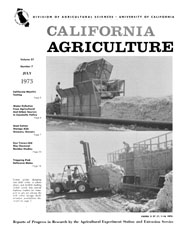


University of California
California Agriculture



|
|||
|
|||

Cover:
Cotton picker dumping into field ricker in photo above, and forklift loading ricked cotton into special highway trailers for transport to gin are among the seed cotton storage mechanization possibilities discussed.
July 1973
Volume 27, Number 7 News and opinion |
|||
|
University of California, 1301 S. 46th St., Bldg. 478 Richmond, CA
|